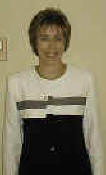
(Demonstration at the Internet Fair of the 37th Annual TESOL 2003
Convention and Exposition, Baltimore, Maryland)
INTERNET
FAIR:
Autonomous
Learning through authentic, collaborative web projects
|
|
INTERNET
FAIR: |
|
Christine
Bauer-Ramazani
|
 |
URLs
for the project:
1. Original web site of the Student Web Projects: http://academics.smcvt.edu/cbauer-ramazani/student_web_projects.htm
2. Publication of the Student Web Projects in Topics
Online Magazine (by Sandy and Tom Peters):
* Restaurant
Reviews by ESL Students (http://staff.uscolo.edu/peterssl/topics/projects/restaurants/project.htm)
* Shopping
for Necessities near Saint Michael's College
(http://staff.uscolo.edu/peterssl/topics/projects/necessities/page.htm)
3. What the teacher has to to say (purpose and process
of the student web projects):
http://staff.uscolo.edu/peterssl/topics/projects/restaurants/christine-b-r-page.htm
4. A CALL Online Student's
Review of the Web Projects:
http://staff.uscolo.edu/peterssl/topics/projects/restaurants/student-review.htm
Hardware requirements: Windows
95/98/NT/2000, XP
Specific browser or plugins required: Internet Explorer 5.0 (or higher)
Authoring materials used: Microsoft FrontPage, Word,
digital camera, scanner
The theoretical and pedagogical implications of authentic, collaborative web projects
This project demonstrates constructivist principles in using CALL projects in the classroom. Students in my advanced intensive English program class collaborated on two projects that integrated all skills of English language learning (listening, speaking, writing, reading) and culminated in the construction of a web page for each project. My goal was to find a project that would provide the students with a type of language immersion by involving them in meaningful, authentic activities that would allow them to collaborate, build on each others' skills, and become autonomous learners. In addition, this project was to be of value to future students and the community at large. Much to my surprise, the students took over the lead for this project and worked mostly outside of class. They decided on the topics, conducted surveys on campus, grouped the data they obtained, ranked the information, and decided how to present it on a web page. My role became that of facilitator and consultant, both for the technological and language aspects. As the students wanted to present a near-perfect web page to the public, they insisted on multiple drafts and revisions of the final web page text that accompanied the surveys, pictures, and maps.